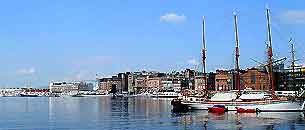University of Oslo
University Information, Campus and History
(Oslo, Norway)
The University of Oslo is the oldest and largest higher education institution in Norway. Its history began in 1811 when Norway was allowed by King Frederick VI, a Danish monarch to found its own university. The original university campus was built in Kongsberg but in 1812, it was moved to Oslo and was named The Royal Frederick University. Rented buildings served as the university's classrooms, which then only had six teachers and 17 students. But starting 1852, enrolment started to increase so that the university needed to expand and build more infrastructure. Its first buildings stood along Slotsveien (today known as Karl Johans gate).
The university began with only four faculties: The faculties of Law, Theology, Medicine, and Philosophy. However, in 1861, the Philosophy Faculty was divided into the Faculty of Mathematics and Natural Science, and the Faculty of Arts. In 1959, the university added another faculty, the Faculty of Dentistry. The last two faculties to be founded were the Faculty of Social Sciences in 1963 and the Faculty of Education in 1996.
Today, the university has eight faculties:
- Law
- Theology
- Medicine
- Humanities
- Mathematics and Natural Sciences
- Dentistry
- Social Sciences
- Education
The university was renamed University of Oslo in 1939. By the 1970s, the university already had 20,000 students. Today, the university is home to over 30,000 students and 4,600 staff members. The university is well known for its excellent research quality, proved by its four Nobel Prize winners. Apart from its research facilities and faculties, the university has a number of affiliated units and independent centres.
The current buildings of the university are spread over different parts of Oslo. The university's buildings are located in Toyen, Gaustad/Blindern, Ulleval/Geitmyrsveien, and in the Oslo city centre.
Facilities
To serve its well-rounded students, the University of Oslo houses several educational and recreational facilities. The university's museums contain collections unique to a particular field of study. The university's museums are the following:
- University Museum of National Antiquities
- Museum of Cultural History
- Collection of Coins and Medals
- Ethnographic Museum
- Natural History Museum
- Botanical Museum
- Paleontological Museum
- Mineralogical-geological Museum
- Zoological Museum
- The Viking Ship Museum
Aside from museums, the university has its own main library, which was founded in 1811. Its main library is the largest Norwegian library. The four faculties, Medicine and Health Sciences; Law; Arts and Social Sciences; and Mathematics and Natural Sciences, have their own libraries containing volumes of books and a vast collection of research materials.
The University Board controls several units and centres. These centres focus on research in the fields of women's studies, biotechnology, environment, and gender research. Some of the university's centres include the Centre for Women's Studies and Gender Research, Biotechnology Centre of Oslo, Centre for Development and the Environment, EMBIO, and International Summer School.
To help its international students grasp the Norwegian language better, the university offers Norwegian language courses. Students also have their own health insurance, but the terms and conditions may vary on their country of origin and stay in the university. Health insurance is acquired using a semestre card obtained every semestral registration.
The Norwegian Students' Society is the oldest students' association in Norway. Founded in 1813, this society is housed in Chateau Neuf and organizes a variety of student activities like lectures, concerts, debates, theatre productions, exhibitions, and parties. Chateau Neuf also offers a restaurant, café, reading room, and library open to all university students.
Its international students automatically become members of the International Students Union (ISU). This union represents all foreign students in Norway and is a non-profit, anti-racist, and non-religious group. The ISU also organizes several social and academic events each year.
Other facilities of the university include a botanical garden, university restaurants and cafeterias, a counselling service, and sports and recreational facilities.
Famous Students
The university has produced outstanding graduates who have excelled in several fields. However, the university is known for its Nobel Prize winners. In 1969, there were two Nobel Prize winners: Ragnar Frisch for Economics and Odd Hassel for Chemistry. Ivar Giæver was awarded the Nobel Prize in Physics in 1973.
Interested international applicants can request information on the university's course offerings, student accommodation, and facilities by emailing international@admin.uio.no. Gather general university information by calling the university switchboard at (+47) 22 85 50 50.
| Contact
University of Oslo: |
Address: Boks 1072 Blindern, NO-0316 Oslo, Norway
|
Tel: +47 22 85 50 50
Email: international@admin.uio.no
Website:
http://www.uio.no |
 |
